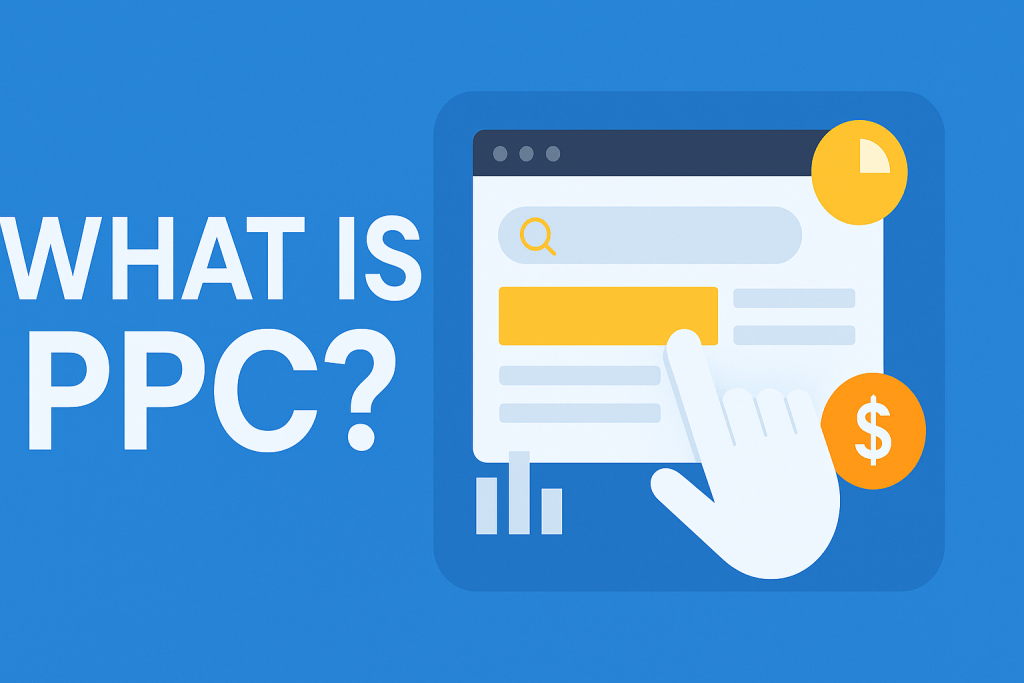Introduction.
In today’s digital-first economy, businesses need more than just a website to grow online—they need visibility. And PPC advertising is one of the quickest ways to get that exposure. If you’ve ever asked yourself, “What is PPC?”, this guide is here to explain it all in detail. From how it works to its benefits and strategies, we’ll uncover everything you need to know about this powerful marketing tool.
Table of Contents
What is PPC?

With the Pay-Per-Click (PPC) online advertising model, marketers pay a fee each time one of their ads is clicked.. In essence, it’s a method of purchasing website traffic instead of obtaining it naturally.
PPC is demonstrated when you search for something on Google and see advertisements at the top of the results. These advertisers pay Google each time an ad is clicked.
So, what is PPC? in real life? It allows you to precisely target your audience, manage your advertising expenses, and see quantifiable return on investment almost immediately.
How Does PPC Work?
PPC advertising follows a bidding model. When a user searches for a keyword that you’ve bid on, your ad may appear in the sponsored results section. But showing up isn’t guaranteed—there’s a competition behind the scenes known as the Ad Auction.
The Ad Auction Process:
- Keywords: Advertisers choose relevant keywords for their business.
- Bidding: You decide how much you’re willing to spend per click, or your maximum bid..
- Ad Quality: Google assesses your ad’s relevance and landing page experience using a metric called Quality Score.
- Ad Rank: This determines whether your ad appears and in which position.
In essence, PPC is about relevance and value. If your ad is helpful and your bid is competitive, you’ll get prime placement.
Popular PPC Platforms:
While Although it’s not the only one, Google Ads is the dominant force in PPC. The most popular PPC platforms are as follows:
- Google Ads- The biggest PPC platform is, which includes YouTube, Display Network, Google Search, and more.
- Microsoft Ads– (Bing Ads): less competitive and frequently less expensive.
- Facebook Ads- Social PPC that targets demographics, interests, and user behaviour.
- Instagram Ads – Ideal for visual products and younger audiences.
- LinkedIn Ads – B2B advertising with targeting based on industry, job title, etc.
- Twitter Ads – Promote tweets to increase engagement.
- Amazon Ads – Perfect for e-commerce and product visibility.
Each platform serves different needs. Paying for each click is the fundamental idea behind PPC, regardless of the platform.
Types of PPC Ads:
PPC advertisements on search engines aren’t just text-based. There are several types to consider:
- Search Ads: Show up on search engine results pages (SERPs).
- Display Ads: Banner ads on Google Display Network websites.
- Shopping Ads: Price and image-based advertisements for products.
- Video Ads: Skippable or non-skippable video ads, mainly on YouTube.
- Remarketing Ads: Focus on people who have already been to your website.
- App Install Ads: Encourage downloads of mobile applications.
You can choose the most effective format to reach your target audience by being aware of the different kinds of PPC advertisements.
Benefits of PPC Advertising:
Still wondering what is PPC? good for? Here are its most compelling benefits:
1. Immediate Results
Unlike SEO, PPC delivers quick visibility. You can begin receiving clicks and conversions as soon as your campaign launches.
2. Targeted Reach
You can segment your audience by location, device, time of day, language, demographics, and more.
3. Measurable ROI
Real-time tracking and optimisation are possible for each click, impression, and conversion.
4. Cost Control
Only when someone engages with your advertisement do you get paid. You also set daily or monthly budgets.
5. Brand Exposure
Even if users don’t click, your ad still appears—giving you free brand exposure.
6. Complements Other Strategies
PPC works well alongside SEO, email marketing, and social media.
Key Metrics in PPC:
Understanding Pay-Per-Click (PPC) advertising isn’t just about launching ads—it’s about knowing what’s working and what’s not. To do that, you need to keep an eye on some essential performance metrics that determine the success of your campaigns. Here are the key ones every marketer should track:
1. Click-Through Rate (CTR)
CTR tells you how many people saw your ad and actually clicked on it. It’s measured as a percentage and shows how well your ad grabs attention. A higher CTR means your message is connecting with your audience.2. Cost Per Click (CPC)
CPC displays the amount you pay each time an ad is clicked. Keeping this cost low while still bringing in quality traffic is the goal. It helps manage your ad spend wisely.3. Quality Score
This is Google’s way of scoring your ad relevance, landing page experience, and expected CTR. The better your Quality Score, the less you may have to pay for clicks—and the better your ad placement can be.4. Impressions
Impressions count how many times your ad has been shown. While it doesn’t mean people are clicking, it does give insight into how visible your ads are to your target audience.5. Conversion Rate
Clicks are great, but conversions matter more. Conversion rate tells you how many people clicked your ad and completed a desired action—like filling out a form or making a purchase. This is a true measure of success.6. Ad Rank
The position of your ad on the search results page is determined by its Ad Rank. It is determined by a number of factors, including your bid amount and Quality Score. Better visibility and possibly more clicks are associated with a high Ad Rank.
By consistently monitoring and analyzing these PPC metrics, you’ll be able to optimize performance, make smarter decisions, and ultimately, run campaigns that are both cost-effective and results-driven.
How to Create a PPC Campaign
Let’s walk through the steps of launching a basic PPC campaign:
Step 1: Define Goals
Start with clear objectives—sales, leads, app installs, etc.
Step 2: Choose a Platform
Based on your audience, pick Google Ads, Facebook, or others.
Step 3: Keyword Research
Use tools like Google Keyword Planner to find relevant, high-intent keywords.
Step 4: Create Your Ads
Compose attention-grabbing calls to action, descriptions, and headlines.
Step 5: Set a Budget
Decide your daily or monthly spend. Start small and scale up.
Step 6: Launch and Monitor
Go live, but keep optimizing. Monitor metrics like CTR, CPC, and conversions.
This process answers not just what is PPC?, but how to implement it effectively.
Common Mistakes in PPC:
Even the best marketers make errors. Avoid these common pitfalls:
- Poor Keyword Match Types: Using broad match can waste money on irrelevant clicks.
- Ignoring Negative Keywords: These help filter out unqualified traffic.
- Lack of A/B Testing: Not testing variations means you miss optimization opportunities.
- No Landing Page Optimization: Great ads need great landing pages to convert.
- Not Tracking Conversions: Without tracking, you’re flying blind.
By recognizing these mistakes, you can run smarter and more cost-effective PPC campaigns.
SEO vs. PPC: Which One is Better?
Both SEO and PPC serve valuable purposes. But they operate differently.
| Factor | SEO | ppc |
| Stops when the budget ends | Organic, but time-intensive | Paid per click |
| Speed | Slow results | Immediate traffic |
| Longevity | Long-term benefits | Stops when budget ends |
| Trust | High (organic) | Lower (labeled as ads) |
| Control | Less control over ranking | Full control over placement |
So, instead of choosing one, combine both. Use PPC for fast results and SEO for long-term growth.
Tips to Improve PPC Performance:
Once you understand what is PPC?, the next step is optimizing it. Here are tips to help:
- Use Long-Tail Keywords: Lower CPC and higher conversion rates.
- Improve Your Targeting: Pay attention to behaviours, interests, and demographics.
- Boost Quality Score: Increase the relevancy of landing pages and advertisements.
- Schedule Your Ads: Show them when your audience is most active.
- Optimize for Mobile: Make sure your mobile landing pages are responsive and quick.
- A/B Test Everything: Headlines, CTAs, images, and more.
Regular optimization ensures your PPC budget delivers the best possible ROI.
Conclusion:
In summary, what is PPC? is not just a question of definition—it’s a fundamental marketing strategy for businesses of all sizes. Whether you’re a local shop or a global brand, PPC gives you the power to reach your audience directly, control your budget, and measure your success in real-time.
Here’s what we covered:
- PPC stands for Pay-Per-Click, a paid advertising model.
- It operates on a bidding system using platforms like Google Ads, Facebook, etc.
- You can choose from different ad formats like search, display, shopping, and video.
- The benefits include immediate visibility, precise targeting, and measurable ROI.
- Optimization and regular analysis are key to long-term success.
So the next time someone asks you, “What is PPC?”, you’ll not only know the answer but also how to use it to grow your business.
